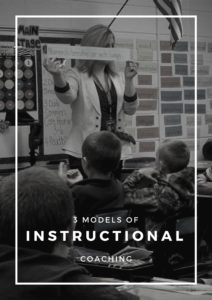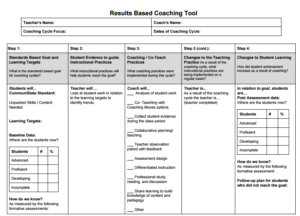3 Models Of Instructional Coaching
There are 3 models of Instructional Coaching. The purpose of an Instructional Coaching Model is to help close the student achievement gap and accelerate learning for all students by building teacher capacity through implementation of effective instructional practices (Casey, 2008). The primary responsibility of instructional coaches is to improve classroom instruction and increase student achievement.

In my research I have found three coaching models that are being used in school districts. I have also been trained in all three. My favorite model, and the model our school chooses to use is Student Centered Coaching by Diane Sweeney. I would highly recommend this model. It really takes the pressure off of both the teacher and the coach. The main focus is on student data, not the teacher, which is non-threatening to teachers. Student data drives instruction, which in return changes or enhances instructional practices. I also like this model best because data and student achievement is the focus. In using this model our focus is on pre assessments, planning formative assessments and using the summative assessment to judge mastery of the standards. This model lends well to differentiation techniques for all students.
However, my team uses concepts from Jim Knight’s training and Cognitive Coaching. The concepts that my team have implemented from the Jim Knight training are the concept that Instructional Coaches are NOT evaluators and the concept of using researched-based strategies. This was a great foundation for our team to start with. Jim Knight also has many great suggestions on how school administrators can help support instructional coaches. Our administration and instructional coaches started with a book study using Jim Knight’s book. A fellow coach and I were also involved in the Elena Aguilar Cognitive Coaching training. We really liked the coaching conversations that this class had to offer. Cognitive coaching is all about the coaching conversations. It’s main focus was on paraphrasing teacher’s reflections and asking the right questions in order to get teachers to get to their own ah-ha moments. My team uses these conversation techniques in our student centered coaching cycles. This technique is great to use during reflections throughout the student centered coaching cycle process.
KANSAS COACHING PROJECT INSTRUCTIONAL COACHING MODEL (Jim Knight)
In the first model of instructional coaching Jim Knight, the Director of the Kansas Coaching Project at the Center for Research on Learning at the University of Kansas has extensively studied instructional coaching methods in schools. Knight commented that the Kansas Coaching Project’s research indicates that efficient coaching models typically take on a three-part cycle: identify, learn, and improve.
Jim Knight’s website: instructionalcoaching.com
3 Part Coaching Cycle:
- Identify a goal
- Identify a teaching strategy to hit the goal
- The teacher learns about that teaching strategy and then they implement and adjustments are made until the teacher hits the goal….
Over time the kind of goals you set, the questions you ask, the process, is very tight and clear. The process itself is adaptable. There’s a recognition that if this practice or this teaching strategy won’t help, we’ll use a different one. Or change the way we measure progress towards the goal. You work with the teacher and make adjustments as you need to, but the steps are pretty consistent.
Relationship Driven Coaching Cycle:
- Establish Equality within the teacher/coach relationship
- Teacher maintains both voice and choice
- Authentic dialogue and application of pedagogy
- Encourage reflection
- Built upon reciprocity- both teacher and coach are learners
- The coach provides support and resources to teachers
- Support is non-threatening and doesn’t challenge teachers
- Data is rarely used
- Sharing access to textbooks, curriculum is the primary focus of coaching
- The coach is viewed as a friendly source of support that provides resources when needed
INQUIRY-BASED & COGNITIVE COACHING: (Elena Aguilar)
Inquiry based or cognitive coaching aims to improve a teacher’s instructional practices by focusing on their underlying thought processes and beliefs. Particularly important in this model is developing a teacher’s “cognitive skills of reflection through discourse and application of knowledge.” Cognitive coaching is the model most clearly described by Elena Aguilar of Elena Aguilar Consulting. Coaching that is truly transformational, she argues, must address teachers’ emotional intelligence, non-verbal communication, and underlying beliefs.
Cognitive Coaching Cycle:
- Begins with examining student learning
- Focuses on what teachers can do differently to improve student learning
- The coach moves the teacher towards implementing instructional practices
- Focus on researched-based strategies
- Summative assessment data is used to hold teachers accountable
- Textbooks, technology and curriculum are primary focus
- The coach is viewed as a person who holds teachers accountable
STUDENT-CENTERED COACHING: (Diane Sweeney)
The model of instructional coaching supported by Diane Sweeney Consulting (DSC) is known as “student-centered coaching.” According to the organization’s website, student-centered coaching is able to achieve a higher degree of impact on students because of its focus on student learning rather than teacher practice and use of data. Figure 1.3 below displays DSC’s comparison between student-centered coaching and teacher-centered or relationship-driven coaching.
Diane Sweeney’s website: Student Centered Coaching
Student Centered Coaching Cycle:
- Coach and teacher are partners based on student learning
- Focus on student data and student work to collaborate
- Formative assessments are used to differentiate
- Data driven instruction
- Summative assessments are used to assess progress towards mastery
- Textbooks, curriculum and technology are viewed as tools
- Coach supports teachers in moving students towards mastery of standards
Trusting, respectful relationships are a necessary component for all forms of coaching. In order to work toward improving classroom instruction, coaches engage in a variety of in-class activities such as modeling instructional methods, observing teachers at work, out of class activities, co-planning, analyzing student data, developing curricula, and conferencing with teachers. This is a tool that our school uses throughout the student centered coaching cycle (adapted from Diane Sweeney).

Student Centered Coaching Tool (Free)
*This post contains affiliate links.


